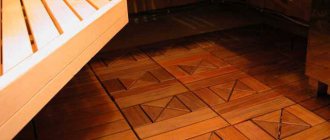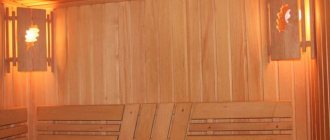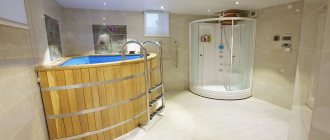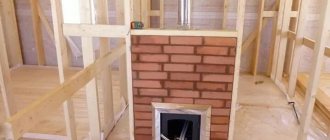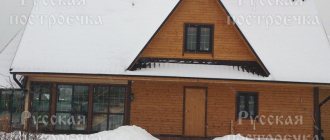The main areas in the bathhouse and the features of using the floors in them
The bathhouse is divided into several thematic areas:
- Steam room.
- Washing room.
- Waiting room.
- Rest room.
There can be even more zones, for example, sometimes a shower and sauna are added. Conversely, some sectors can be combined and reduced to two - an area for direct procedures and a locker room/rest room. Therefore, the whole question of how to cover the floor in a steam room of a bathhouse comes down, first of all, to the degree of exposure to harmful factors in a particular place.
The most extreme conditions for the floor are created in areas of high humidity and temperature, as well as from exposure to detergents. At the same time, in the waiting room these destructive factors are practically excluded. However, the proximity to the bathhouse and the street always carries excess moisture. Therefore, even here it is necessary to use special processing tools.
The main factors of material destruction are:
- Heat.
- High humidity.
- Water.
- Formation of mold and mildew.
- Detergents.
- Temperature changes during the cold season.
Destruction of a wooden floor in a bathhouse by rot Source ytimg.com
Important! When choosing a treatment product, it is first necessary to take into account the likely harm to human health, and only then the degree of protection of the materials.
Bathhouse, steam room, washing room
Premises in direct contact with water and heat are exposed to the most destructive factors. Therefore, first of all, you need to know how to cover the floor in the bathhouse and steam room. As a rule, there is a special antiseptic for this. However, the effectiveness of the products used depends not only on the composition, but also on the structure and material of the floor surface.
In the steam room and washing area, the floor is made of wood or concrete. The first option has two varieties:
- Torrential . It is lined with boards located at a short distance from each other. Water naturally drains down into the gaps that form during bathing procedures.
- Solid . It also has a wood base, but unlike the version described above, water does not pass through the surface, but goes into the sewer system through specially equipped drains.
Water-filled floor in the bathhouse Source ytimg.com
The concrete floor in the bathhouse is continuous and sloped to facilitate water removal. A wooden sheathing is usually placed on top of the screed. A metal flat bowl for catchment can be additionally installed at the bottom of it. In addition, tiles made from natural or artificial materials are often laid at the final stage of finishing.
Important! The use of a wooden or concrete floor in a bathhouse in winter requires insulation. This is only possible with proper hydro- and vapor barrier. At the same time, all structural elements must be treated with an antiseptic to eliminate the processes of rotting, mold and mildew.
Dressing room, rest room
The steam room and washing room are only half of the bathhouse, because in many ways the effect of the procedures depends on the correct subsequent rest. Therefore, it is also important to know what the floor in the dressing room should be like - what is best to make it from in order to provide all the necessary conditions for the relaxation room and locker room.
Insulation of the floor in the dressing room with expanded clay Source banyabest.ru
See also: Catalog of companies that specialize in the construction and repair of baths and houses
The floor in the dressing room is made based on how the bathhouse itself is used. If it is fully used all year round, then the floor surface must be insulated. The peculiarities of the operation of this room are that steam, splashes, dampness, and temperature contrast will also be constantly present in it. They are protected by a properly selected coating and a well-assembled structure - double flooring, insulation, hydro- and vapor barrier.
Advice! For comfortable use of a bathhouse at any time of the year, it is important to know not so much how to make a floor in a dressing room, but how to properly insulate it. When leaving the steam room to relax, a person can easily become hypothermic from contact with a cold floor covering. The optimal modern solution is the installation of heated floors. As a technical solution, heating can occur through pipes with water heated from a sauna stove.
Modern heated floors in the bathhouse Source pikabu.ru
Arrangement of rough flooring
The subfloor is intended to support the insulation layer between the subfloor and the facing flooring. It is made from short pieces of thin boards nailed to the joists on the underside.
The subfloor is not visible from the outside and is not subject to stress when walking. Therefore, it is not at all necessary to use a high-quality floorboard with a length equal to the length of the bathhouse.
Attention! For the subfloor, it is rational to use scraps of boards obtained during the construction of other elements of the bathhouse. There is especially a lot of such waste during the construction of panel baths
The subfloor is assembled from unplaned boards or from others that are available. Also, the board does not have to be tongue-and-groove. A regular edged one will do.
Typically, a subfloor is constructed in a bathhouse in a recreation room. In the steam room, its function is performed by a concrete surface that collects water (waste system). Antiseptic treatment for subfloors is required.
What, when and with what to start processing
Before you start looking for a solution to the question of how to cover the floor in the bathhouse vestibule, you need to find out which places to treat first and which ones secondarily. You need to start with the structural elements located at the very bottom - the floor beams. This is done at the stage of construction of the log house. It is advisable to pre-process and dry them - even before placing them in the lower crowns.
You need to use special antiseptics for baths for this purpose. The number of layers depends on the instructions, manufacturer and component composition. However, in most cases it is recommended to impregnate the beams at least 2-3 times, after each complete drying of the previous layer.
Here it should be taken into account that this structural element will not be accessible during operation and will be subject to maximum exposure to destructive factors. In addition, the durability of the flooring will depend on its preservation.
Creating a double sex in a bathhouse Source blog-potolok.ru
Important Tips
When choosing a paint and varnish mixture, you need to pay attention not only to the color and period of its service, but also to the following points:
- Specifics of wood covering. To process different types of wood, it is necessary to use different coloring compounds, which is determined by the structure and density of the material;
- Intensity of use. Oil mixtures have the greatest wear resistance, so they can be used in rooms with a high degree of load on the floors;
- Service period. The paint that will last the longest in a bathhouse is the one that is most resistant to moisture, i.e. based on acrylic or water emulsion.
It is worth considering that a change in paint color sometimes indicates imminent cracking of the coating. To prevent the wood from getting wet, it is advisable to re-paint the floors.
Choice of impregnation
In order to reliably protect the floor structure from rot, fungus and other destructive factors, you need to know exactly how to cover a wooden floor in a bathhouse - namely, what types of impregnation exist for this. Today on the market you can buy compositions of the following 4 modifications:
- Water soluble . Suitable for rooms where direct exposure to water is excluded - dressing room, rest room, locker room.
- Organic solvent based . Ideal for use in steam rooms, washing rooms, showers - where there is maximum surface contact with water.
- Oil solution . Limited in use - suitable for areas with slight differences in humidity and heat.
- Combined . It has a universal set of properties - water resistance, antiseptic, fire protection.
Recommendation! Before applying impregnation, a long-painted, whitewashed or varnished surface should be cleaned down to the wood layer, carefully sweep away the shavings and sawdust and dry.
Colored impregnations for wood Source instrumentgid.ru
Features of the use of paints
Before painting, the floor surface is sanded and degreased.
Painting a rest room does not have any special restrictions in the choice of tinting compounds. Can water-based or oil-based mixtures be used to paint the floor? Since the rest room does not have a harsh microclimate, almost any type of paint and varnish mixtures can be used to treat the floor.
To prevent the painted surface from starting to crack within a couple of months after application, you need to paint the rest room as follows:
- The coating is cleaned of dirt and oil stains;
- The wood is first sanded to improve the adhesion of the paint to the floor surface;
- Before use, stir the paint and varnish mixture thoroughly;
- The paint is applied to the coating in several layers using a soft brush or roller;
- Oil stains that appear on the surface are removed with a sponge.
Selecting a Finish
Knowing how to cover the floor in the dressing room or the bathhouse itself will not only give the finish a modern, stylish look, but also preserve the surface from premature destruction. Varnishes and paints are used for finishing.
Varnish coating
The floors in the bathhouse are varnished at the final stage - after the previously applied impregnation has dried. In this case, you need to select either a composition specially designed for bath rooms, or one that does not include toxic substances and does not release their dangerous derivatives when heated.
Positive effects of varnishing the floor in a bathhouse:
- Protection of the flooring from mechanical damage (abrasion, drying out, cracking).
- Increasing the resistance of wood to physical and chemical factors - temperature changes, moisture, detergents.
- Giving the material antiseptic properties - which will provide it with protection from insects, microorganisms and fungi.
Impregnating the floor with varnish Source nadoremont.com
Apply varnish to the surface only after it has been thoroughly cleaned and dried. For even distribution it is better to use a roller or brush.
Painting
It is permissible to paint bath floors only using special paint. It should not contain harmful substances, including their release under the influence of hot water, air and radiation from heating devices.
When choosing paint, you need to take into account both the operating conditions of the room and the type of wood. For example, for coniferous species it is extremely undesirable to use compounds that form a dense, hard surface layer after drying. This can only worsen the situation with the formation of rot.
Advice! Oil paints are well suited for painting wooden bath floors. Among other advantages, they are distinguished by a wide range of colors, form a durable surface layer after drying and keep the natural texture of the boards visible.
Material requirements
It is desirable that the color of the paint emphasizes the texture of the wood and does not overlap its wood pattern.
Which paint is suitable for painting floors in a “damp” room? Paint and varnish products intended for use in extreme conditions must have the following qualities:
- temperature stability;
- resistance to moisture;
- non-toxic;
- antifungal properties;
- resistance to mechanical damage.
In addition, it is desirable that the paint color emphasizes the texture of the wood and does not overlap its wood grain. To paint a concrete floor, you need to purchase compounds with dust-removing properties and good adhesion to mineral substrates. Otherwise, the protective layer will crack very quickly.
A brief overview of moisture-resistant varnishes, all the pros and cons
After the floor has been treated with an antiseptic, it can be varnished. It is this material that allows you to highlight the color and texture of the wood. But, in addition to beauty, it is important to ensure the safety of the coating.
Tip #2. Note! Conventional varnishes cannot be used for the steam room and washing room! When heated, they release toxic substances. They also have high thermal conductivity, which can lead to burns.
For baths, steam rooms and garbage disposals, only special varnishes are used. These include:
| Brand name | Advantages | Price |
| Neomid Sauna | Thanks to the acrylic base, it has high elasticity and breathability. This does not create cracks when heated and cooled. Protects the floor from biological interference. | From 400 rub. for 1 l. |
| "Eskaro Sauna Lac" | A distinctive feature is the deep impregnation of the material. This provides reliable protection against unfavorable microorganisms, high humidity and temperature. | From 1500 rub. for 2.4 l |
| "Atom Color" | Acrylic varnish for all bath surfaces. It is applied at a temperature not lower than + 100. You can heat the bathhouse for the first time only after the varnish has completely dried. | From 335 rub. for 1 l. |
Varnishes protect wood from destruction and complement the decorative properties of the material.
About the tools
A wide brush, rollers, a spray bottle - anything will do. To finish the seams, use a thin brush.
But if you follow the advice of experts, then initially it is better to paint with a brush, and apply a second layer with a spray gun. Why? Because if there is dust, etc. left on the surface of the wood, then the sprayed paint, after drying, can quickly peel off or crack, and a brush reduces such problems.
At the same time, the sprayer practically does not raise wood fibers. This means that the surface will remain smoother and sanding will be much easier. By the way, after spraying, the surface of the logs acquires a glossy appearance, and brushes and rollers give a matte tint.
The primer can also be applied with a spray bottle. At the same time, do not neglect protective equipment (goggles, gloves, respirator), although for some chemicals it is better to use hard brushes, which allow you to rub them in more efficiently.
Regarding the weather: slightly cool, but “plus” weather without precipitation and strong winds is most suitable.
Types of paint and varnish products
Some types of materials contain formaldehydes, which begin to evaporate when exposed to high temperatures. Which paint is best for treating flooring in a bathhouse? Before purchasing coloring compounds, you need to familiarize yourself with their classification. Based on the method of painting, paints can be divided into two types:
- Construction and household. Easy-to-use formulations that are sold ready-made. They are cheaper than professional ones, but the quality of such materials is much worse;
- Professional. Difficult to use materials, the preparation of which is impossible without knowledge of technological maps for paint and varnish products. Professional floor paint contains emulsions that significantly increase the service life of the protective layer.
Is it possible to use regular coloring compounds to treat the floor in a bathhouse? Some types of materials contain formaldehyde, which, when exposed to high temperatures, begin to evaporate from the surface of the coating. They can only be used in the rest room, since the air temperature in it rarely rises above 27-30 degrees. In the sink and steam room, the temperature can rise to 80-90 degrees, so cheap paint in them will begin to release harmful chemicals, which is fraught with negative consequences for health.
Which vapor barrier to choose for the ceiling, its types and cost
Useful video
Video about applying oil to a tongue-and-groove floor in a log house:
Well, we told you everything we knew about floors, and for those who are planning to or have already started decorating a bathhouse, we advise you to look at the section dedicated to the topic of painting.
The dressing room is a room that serves as protection from the entry of cold air from the street into the bathhouse. When you have to design a dressing room, you need to adhere to some rules.
If the bathhouse is small in size and there are no other functional rooms, then the dressing room can serve as a rest room, locker room, or hallway. Taking into account such factors, you need to think carefully about how to paint the floor in the dressing room, and what material to choose for this.
The main materials for finishing such a room are wood, paint and varnish.
In the dressing room, the floor provides a constant flow of water, which means that the floor surface must be warm, pleasant to the touch and for bare feet. This is a room where there is high air humidity and water drips onto the floor and seeps into the cracks. Having a cold floor in such a room is dangerous to health. Therefore, materials for construction and floor treatment must be selected carefully. They should not cool or heat up quickly. The best option is wood with additional coatings. But not all types of wood can be used for flooring. You need a tree that does not rot: oak, larch. You should also not experiment with compositions for painting and treating floors; it is better to stick to proven methods.
Painting the stove
In addition to deciding what is the best way to paint the inside of the bathhouse, you should also take care of the design of the stove. As a result, this element of the steam room will not only provide warmth, but also serve as a beautiful interior detail.
Of course, the best option would be to use special enamels that can withstand temperatures up to + 600 o C. If this option does not suit you for aesthetic or economic reasons, the stove can be decorated in the old Russian style - whitewashed with chalk or lime.
Regardless of the material chosen, the surface must be prepared accordingly. The surface should be thoroughly plastered, getting rid of minor defects, irregularities and potholes. As a last resort, treat the seams between the bricks with a special clay mortar.
The stove in the bathhouse can be whitened with chalk or lime
Whitewashing with chalk
To do this you need to prepare a special solution:
- Place pieces of chalk in a bucket, fill them with water and leave for an hour.
- In a separate container, mix animal glue and water in proportions of 25:1.
- Combine both solutions and mix until a homogeneous composition is obtained.
To make the surface look more aesthetically pleasing, you can apply two layers. The next one is applied only after the previous one has completely dried.
Lime whitewash
You can prepare a solution from 1 kg of lime (slaked) mixed with 1.5 liters of water. You can add one teaspoon of drying oil, 25 grams of blue and a pinch of salt. This will give the whitewash an attractive bluish tint.
Acrylic-based antiseptics
Acrylic products not only protect wood, but also give different shades.
Acrylic-based antiseptics help prevent the development of almost all types of pathogens. Before application, they are diluted with water, after which they are applied to walls, joists and floor boards. The distinctive features of such antiseptics include:
- Resistance to temperature fluctuations, which allows surface treatment not only in the rest room, but also in the washing room or steam room;
- Resistance to moisture, which helps prevent wood swelling, which subsequently leads to warping;
- High vapor permeability, thanks to which the wood can “breathe”.
If desired, this impregnation can be applied with your own hands. But before breeding and processing wooden surfaces, it is recommended to use protective glasses and gloves that will protect the skin and eyes from contact with the synthetic product.
As a result of polymerization, drying oil forms a very durable protective film
Drying oil is a film-forming composition that is made on a plant basis. Drying oil can be used to treat wooden coverings in the following rooms:
- washing;
- steam room;
- rest room;
- dressing room
As a result of polymerization, the liquid composition forms a very durable protective film that prevents moisture from entering the wood. Drying oil is used to treat coatings not only for disinfection, but also to prevent the appearance of splinters.
Types of insulation
The competent choice of heat insulator for wooden and concrete floors deserves special attention. Due to the specific microclimate in the steam room, it is undesirable to use mineral insulation. This is due to several reasons:
- When wet, the thermal conductivity of the insulator increases;
- Damp mineral insulation is an ideal substrate for the development of pathogens: mold or mildew.
Having decided to insulate the floors with your own hands, it is advisable to choose the following heat insulators:
- Perlite is a lightweight material with minimal thermal conductivity, which is added to cement mortars to reduce the thermal conductivity of the screed;
- Expanded polystyrene is a non-hygroscopic insulation material that can be used to insulate both wooden and concrete bases;
- Polystyrene foam is a thermal insulating material that is similar in its technical characteristics to expanded polystyrene.
The most common causes and solution to the problem
Let's look at the most common options that cause the floor to rot:
Option #1. The products don't do their job
There are too few vents in the house, up to 6, and they are located low to the ground. This makes airflow almost impossible and the environment becomes too humid over time. The joists and floors are rotting.
What to do: instead of insulation in the floor pie, lay a moisture-proof membrane that will control the movement of water. Next, organize a ventilation gap using counter slats across the beams. There should be a gap and ventilation slots on the ventilated baseboard. This way any possible moisture will be dried out. And, if the vents are not working enough, there should be some other ventilation under the floor. Usually this is a metal corner in the floor with holes - that's enough.
Option #2. The ground is too close
The wooden floor is laid on logs, and underneath there is earth, at a distance of up to 20 cm. Such a floor will deteriorate very quickly. And it’s precisely these kind of constructions that would-be builders often make in private homes – quickly and angrily, as they say. Sometimes, however, instead of earth you can find wet clay there, and the result is the same.
What to do: definitely redo the floor: waterproof it into a pie, raise the floor itself higher to regulate moisture, and protect it well from dampness. Another option is to put geofabric on this soil, and sand with good compaction on it. It will not conduct water upward, even if there were no geofabric (this is prevention) - just like the sand on the seashore is dry, but if you dig deeper, it is wet.
Here is an example of the joists being close to the ground, and they were raised during the process of replacing the floor:
Option #3. Hopelessly damp basement
It will be difficult to remove moisture from it, and it will still (even with good ventilation) reach the floor boards. High groundwater is especially dangerous for floors.
What to do: in this case, it is better to abandon it completely, foam the vents and completely cover it with clean river sand. Water each layer generously and compact it well. Lay plastic film and insulation on top of the sand cushion, then plywood, and then the floor itself. And, most importantly, remove the water as much as possible from the house itself - using external drainage. Usually, even pipes around the house are enough, but sometimes ordinary people build small groundwater storage tanks nearby - deep holes. It’s not even difficult to pump water out of there.
Option number 4. Vapor barrier installed incorrectly
It often happens that a certain material is laid the way the floor was designed, and then the boards suddenly rot. This happens because the person laying the floor did not study the instructions for the vapor barrier itself - different manufacturers have very different requirements for its installation. So, materials of one brand should fit tightly to the insulation, while others should have a ventilation gap between them.
How to make: instructions
These instructions depend on what type of foundation you have. If you are making a poured floor, it will be attached to the foundation.
Let's assume that you have a strip foundation. Then there are two options: either lay the logs directly on the tape, or first place the strapping beam on the tape, and the logs are attached to it. But to lay the strapping beam, you must first provide for the installation of anchors directly into the concrete of the strip that has not yet hardened. The timber is placed on anchors and tightened with bolts.
If the foundation is piled or columnar, then it is connected by a grillage, which can be wooden or metal. In both cases, the logs will be attached to the grillage in approximately the same way (taking into account the grillage material) in the previous option.
ADVICE! It is clear that boards are placed on the joists with a gap of, say, 1 cm. But do not forget that you need to leave a gap between the boards and the wall, and its value is 1-1.5 cm.
How to make a concrete screed and drain. You will have to start by creating a drainage system or digging a trench through which water will be discharged either into a septic tank or into a drainage field.
The drainage system under the floor is a sand bed, on top of which gravel is poured. However, on clay soils this will not help much.
If the water is to be drained, then you first need to completely remove the soil layer from the ground, pour 10 cm of sand, then gravel.
Under the future drain you need to make a pit - a concrete tank into which used water will flow and leave through the pipe.
The simplest drainage scheme with a pouring floor
The sand and gravel cushion is covered with a layer of waterproofing (roofing felt, for example). Then there is a layer of insulation (often polystyrene foam), on which a reinforcing mesh is laid. Everything is filled with concrete.
A slope is made on top of the rough screed, which converges towards the pit.
This option is suitable for owners of bathhouses with a strip or columnar foundation.
The technology does not change if you decide to make a waterproofed (dry) floor covered with ceramic tiles.


